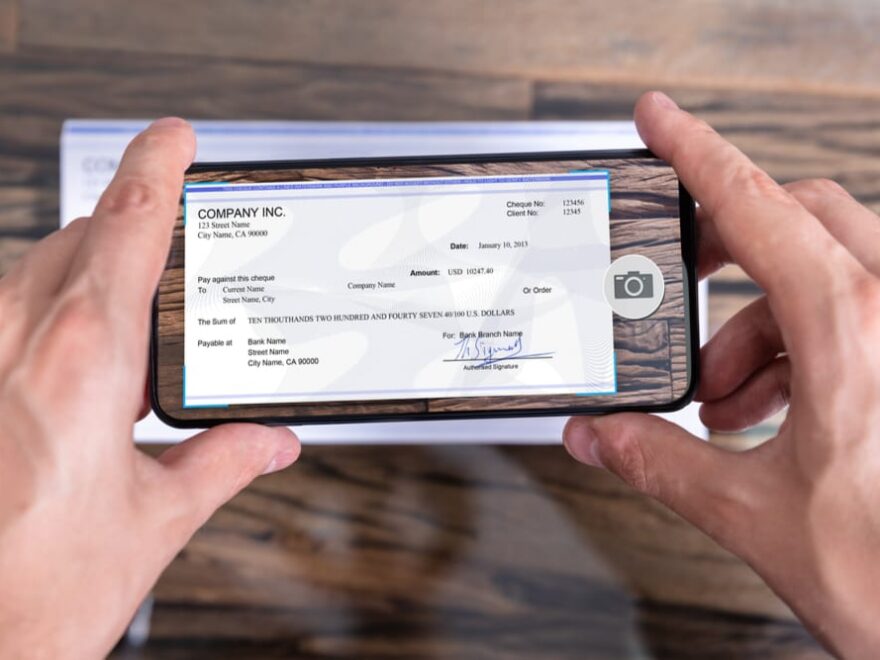How to avoid mobile deposit scams
With more than 160 million Americans using some type of digital banking as of 2019, mobile banking is becoming more and more widespread.
In the US, 89% of banking customers will use mobile banking in 2021 to handle their accounts, and by 2024, more than 3.6 billion individuals are expected to utilize online or mobile banking.
Unfortunately, the ease of online banking has made it easier for frauds involving deposits and fraudulent transactions.
Mobile deposit scams are one of the most popular methods that online hackers are robbing people of their hard-earned money. Every year, banks lose more than $1 trillion to various sorts of cyber crime worldwide.
A mobile banking customer uses their phone to deposit a check
Fake checks are deposited into victims’ bank accounts as part of mobile deposit scams or fake check fraud to obtain their money.
The victims are then asked to retrieve the money and return it, typically through a third-party money transfer account, after these deposits have been made.
Cyber criminals frequently fabricate elaborate justifications for why they cannot access the money themselves when committing mobile deposit fraud, which frequently gives their justifications a more credible air.
As of 2019, fraudulent checks and remote deposit captures were used in 72% of mobile banking scams.
The Consumer Sentinel Network database of the Federal Trade Commission (FTC) shows that more than 27,000 fraudulent checks frauds were recorded in 2019, with losses totaling over $28 million. Scams involving mobile deposits frequently target seniors and young persons, particularly those under the age of twenty.
51% of these frauds make lucrative employment or career claims; 18% use internet marketing schemes; and 4% make grants or incentives claims.
Several remote deposit fraud schemes
There are many various types of remote deposit fraud, but the two most common ones use bogus payday lenders and job postings.
Dating apps and sweetheart scams
$304 million was lost as a result of sweetheart scams last year, a 50% rise from 2019.
Cyber criminals construct phony profiles on dating websites or apps like Hinge, Tinder, or Craigslist to pull off this dating apps or romance scams.
They strike up talks with their targets and develop rapport and trust over weeks or months. Once a “connection” has been formed, they will ask for money for an unexpected medical bill, funeral costs, or hospital bill.
These con artists frequently demand money from their victims via wire transfers or the opening of new bank accounts. Then, before the wire transfer, the stolen funds are placed into the new account.
These con artists frequently claim to be abroad and may demand that victims switch from using dating apps to personal email or text communications right once.
For several reasons, sweetheart scams can be disastrous. They can not only steal a victim’s life savings or hard-earned money, but they can also betray the trust by pretending to be in a real romantic relationship.
Phony job postings
Work-from-home fraud has increased in recent years as more jobs have become remote. People in their 20s and 30s are frequently the target of these frauds, especially those seeking remote jobs with flexible hours.
The adverts for nonspecific employment like mystery shoppers or vague marketing positions used in these mobile deposit frauds entice job seekers.
After applying, a person is prompted to provide their banking details so they can access an online deposit to pay for employment-related fees.
Once the con artist obtains the necessary information, they leave their victims’ bank accounts in the red.
How can you guard against mobile deposit scams?
Even though it is simple to feel helpless in the face of banking scams, there are several measures to safeguard yourself. Here are some pointers to assist you to safeguard your financial data:
Financial or banking-related emails or messages that seem too good to be true should be avoided at all costs, especially if you are asked to provide personal information or data.
- The victim is requested to return the money through wire transfer or gift cards by the offender.
- The victim is asked to maintain interactions with others in person or online. private
- Fraudsters send erroneous emails or requests for money.
- Victims are prompted for their internet banking login credentials.
Look up the source. Verify the legitimacy of the instructions by getting in touch with the source directly if an email or text message requests personal information.
Use a safeguarded, safe checking or savings account from a reputable bank, like Texas Tech Credit Union, and keep a close eye on your account activities.
Don’t make the mistake of merely reviewing your bank statements once a month. Check them at least once per week to look for any unusual activities.
Give no one your details. Say you’ll call them back and use the phone number on your debit card if your bank calls to ask you to confirm your information.
Keep social media accounts secure. Social networking is a tool that cyber criminals use to learn more about their victims, including their banking and shopping habits. Don’t spread this knowledge too widely.
Thanks for visiting US Map of State

